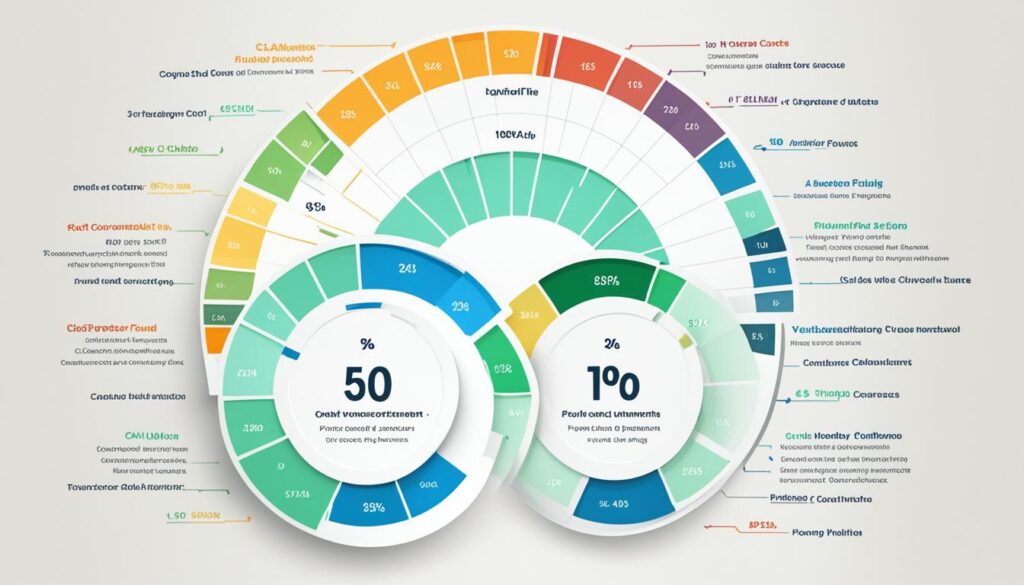In the dynamic world of startup funding, there’s a common perception that venture capitalists (VCs) are modern-day pioneers, leading the charge with their own money to nurture the next generation of innovative companies. But is this the reality, or is it simply a myth? As we delve into the inner workings of the venture capital industry, we’ll uncover the truth behind the money that fuels these high-stakes investments.
Venture capitalists are often portrayed as risk-takers, willing to bet their own fortunes on the promise of disruptive technologies and industry-changing ideas. However, the landscape has shifted, and today’s VCs operate more like conservative bankers than adventurous investors. They’ve carved out a specialized niche in the capital markets, catering to the needs of institutional investors, entrepreneurs, and investment bankers alike. But the question remains: do VC firms actually use their own money, or are they merely managing the funds of others?
Key Takeaways
- Venture capitalists today are more akin to conservative bankers than risk-takers of the past.
- VC firms have become specialized intermediaries in the capital markets, serving the needs of various stakeholders.
- The popular perception of VCs as daring investors putting their own money on the line may not reflect the current reality.
- Understanding the true nature of VC firm financing and investment strategies is crucial for entrepreneurs and investors.
- Delving into the nuances of VC fund structures and revenue sources can shed light on the role of personal capital in the industry.
Understanding Venture Capital Firms
Venture capital (VC) firms play a vital role in the startup ecosystem, providing essential funding and strategic guidance to help innovative companies grow and thrive. These specialized investment firms are structured to identify, invest in, and nurture promising startups with the potential for substantial returns.
What is a Venture Capital (VC) Firm?
A VC firm is an investment management company that pools funds from investors, typically institutional investors and high-net-worth individuals, to invest in early-stage or growth-stage companies. These firms employ a team of experienced professionals, known as venture capitalists, who are responsible for sourcing, evaluating, and managing investments in promising startups and emerging businesses.
The Role of VC Firms in the Startup Ecosystem
VC firms are instrumental in supporting the growth and development of the startup ecosystem. They not only provide the necessary capital for startups to scale their operations but also offer valuable expertise, industry connections, and strategic guidance to help these companies navigate the challenges of building a successful business. By leveraging their VC firm structure, VC firm operations, VC firm portfolio management, and VC firm investment strategies, VC firms play a crucial role in nurturing innovation and fostering economic growth.

The Myth of Venture Capitalists as Risk-Takers
The popular mythology surrounding the U.S. venture-capital industry derives from a previous era when VC firm risk-taking and hands-on operating experience were the hallmarks of venture capitalists who nurtured the computer industry in its infancy. Today, however, the reality is quite different, and it’s crucial to separate the myths from the realities to understand this important component of the U.S. economy.
Contrary to the popular perception, modern-day venture capitalists are more akin to conservative bankers than the risk-takers of the past. They have carved out a specialized niche in the capital markets, filling a void that other institutions cannot serve. Their VC firm investment strategies are focused on maximizing returns through calculated investments in industries that are more competitively forgiving than the market as a whole.
The VC firm return expectations are not driven by investing in good ideas and good plans, as the myth would suggest. Instead, venture capitalists structure their deals in a way that minimizes their risk and maximizes their returns, even in the face of inherently risky businesses. Their VC firm portfolio management approach is centered on identifying and investing in industries that offer a more favorable competitive landscape.
The venture capital industry has evolved significantly, moving away from the legendary risk-taking and hands-on mentorship of the past. Today’s venture capitalists are more akin to sophisticated financial institutions, leveraging their expertise and resources to navigate the complexities of the startup ecosystem and generate consistent returns for their investors.

The Structure of VC Funds
At the heart of the venture capital industry lie the VC funds that serve as the primary investment vehicles. These funds are structured in a unique way, with distinct roles for General Partners (GPs) and Limited Partners (LPs). Understanding this structure is crucial in navigating the intricacies of the VC fund management and the investment period.
General Partners (GPs) and Limited Partners (LPs)
The General Partners (GPs) are the venture capital firms that manage the VC fund. They are responsible for sourcing deals, conducting due diligence, and making investment decisions on behalf of the fund. The Limited Partners (LPs), on the other hand, are the institutional investors, such as pension funds, endowments, and high-net-worth individuals, who provide the majority of the capital for the VC fund.
Fund Management and Investment Period
The VC fund management process involves the GPs actively overseeing the fund’s portfolio, providing strategic guidance to the startups, and eventually facilitating the exit of their investments, typically through an initial public offering (IPO) or acquisition. The investment period of a VC fund is typically around 10 years, with the first 5-7 years focused on making new investments, and the remaining years dedicated to managing and exiting the fund’s portfolio companies.

Sources of Revenue for VC Firms
Venture capital firms generate revenue through various streams, each playing a crucial role in their overall financial model. Two primary sources of revenue for VC firms are management fees and carried interest, along with capital gains from successful investments.
Management Fees
VC firms typically charge an annual management fee, which is a percentage of the committed capital in the fund. This fee, often ranging from 1.5% to 2.5%, covers the firm’s operational expenses, such as salaries, office overhead, and investment research. Management fees provide a steady stream of revenue for VC firms, allowing them to maintain their operations and support their investment activities.
Carried Interest and Capital Gains
The second major revenue source for VC firms is carried interest, which is a share of the profits generated from successful investments. Typically, VC firms receive 20% of the net profits from their funds’ investments, with the remaining 80% going to the limited partners (LPs). This carried interest structure aligns the incentives of the VC firm with the performance of the investments, as they only earn a share of the profits when their portfolio companies generate significant capital gains.

By leveraging these revenue streams, VC firms are able to maintain their operations, attract top talent, and continue investing in promising startups, all while aiming to deliver high returns to their limited partners.
Do VC firms use their own money?
When it comes to venture capital (VC) firms, one common misconception is that they solely invest institutional money from limited partners (LPs) such as pension funds, endowments, and high-net-worth individuals. However, the VC firm capital commitment and the VC firm GP capital investment play a crucial role in the overall investment strategy and alignment of interests within the VC ecosystem.
GP Commitment and Skin in the Game
General partners (GPs) of VC firms are typically required to make a meaningful personal VC firm personal investment requirement into the fund they manage. This “skin in the game” helps to ensure that the GPs’ interests are aligned with those of the LPs, as they have a vested interest in the success of the portfolio companies. The GP commitment, which can range from 1% to 5% of the total fund size, demonstrates the VC firm’s confidence in its investment strategy and ability to generate returns for its investors.
Personal Capital Requirements for VCs
In addition to the GP commitment, many VC firms also have VC firm personal investment requirements for their individual investment professionals. These requirements ensure that the VCs have a personal stake in the success of the investments they make, further aligning their interests with those of the LPs and the portfolio companies. This personal investment requirement can take the form of a minimum capital contribution or a percentage of the VC’s personal net worth.

By leveraging their own capital alongside that of their institutional investors, VC firms demonstrate their commitment to the success of their portfolio companies and the overall VC model. This alignment of interests is crucial in the high-risk, high-reward world of venture capital investing.
Fund Size and Performance Correlation
Contrary to the popular perception of venture capitalists as risk-takers, research suggests that VC fund performance actually declines as fund size increases beyond $250 million. This finding underscores the importance of VC fund size and its impact on VC fund performance and VC fund returns.
The venture capital industry is often romanticized, with the popular press filled with stories of Silicon Valley entrepreneurs overcoming the odds. In these sagas, the entrepreneur is cast as the modern-day cowboy, exploring new frontiers, while the venture capitalist serves as a seasoned sidekick, ready to guide the hero through any challenges – in exchange for a share of the success.
However, the reality of the VC industry is more nuanced. VC fund investment strategies have evolved, and VC firms have become more akin to conservative financial institutions, focused on maximizing returns through calculated investments in industries that are more competitively forgiving than the market as a whole.
| VC Fund Size | VC Fund Performance | VC Fund Returns | VC Fund Investment Strategies |
|---|---|---|---|
| Less than $250 million | Higher performance | Potentially higher returns | More focused on high-growth, innovative sectors |
| Greater than $250 million | Declining performance | Potentially lower returns | More diversified, less specialized investments |
As the VC industry has evolved, understanding the nuances of VC fund size, VC fund performance, VC fund returns, and VC fund investment strategies is crucial to separating the myths from the realities of this important component of the U.S. economy.

The Venture Capital Investment Cycle
The VC investment process is a carefully orchestrated sequence of activities that VC firms undertake to identify, evaluate, and ultimately invest in promising startups. At the heart of this cycle lie two critical components: deal sourcing and due diligence.
Deal Sourcing and Due Diligence
VC firms employ a range of strategies to source potential deals, from leveraging their extensive networks and industry relationships to actively scouting for promising startups. This deal sourcing process is crucial, as VC firms must identify the most promising investment opportunities within their target industries and sectors.
Once a potential investment is identified, VC firms then embark on a rigorous due diligence process, delving deep into the startup’s financials, management team, market potential, and competitive landscape. This meticulous analysis helps VC firms assess the viability and growth potential of the venture, ensuring they make informed investment decisions that maximize their chances of generating superior returns.
Portfolio Management and Exit Strategies
If a startup successfully secures VC funding, the VC firm then takes on the role of active portfolio management, providing strategic guidance, industry expertise, and hands-on support to help the company navigate the challenges of scaling and growth. This collaborative approach is a hallmark of the VC model, as VC firms leverage their network and resources to nurture their portfolio companies.
Ultimately, VC firms seek to generate returns for their investors through well-timed exit strategies, such as initial public offerings (IPOs) or strategic acquisitions. By carefully managing their portfolio and identifying the optimal exit opportunities, VC firms aim to deliver the exceptional returns that their limited partners expect, completing the VC investment cycle.

Challenges and Trends in the VC Industry
As the venture capital (VC) industry matures, it is facing a number of significant challenges and emerging trends that are reshaping the landscape. One key issue is the increasing competition within the VC industry, as more players vie for a limited pool of high-potential startups. This industry consolidation has led to a more crowded and competitive funding environment, making it increasingly difficult for individual VC firms to stand out and secure the best deals.
In addition, the VC industry is grappling with the rise of alternative funding sources, such as crowdfunding platforms, angel investors, and corporate venture capital. These new avenues for startup financing are disrupting the traditional VC model and forcing VC firms to adapt their investment strategies to remain relevant and competitive.
Competition and Industry Consolidation
The VC industry competition has intensified in recent years, with more VC firms chasing a limited number of high-growth startups. This has led to a consolidation within the industry, as larger VC firms acquire smaller players or expand their own operations to maintain their competitive edge. This trend has implications for entrepreneurs seeking funding, as they may face fewer options and more stringent investment criteria from the remaining VC firms.
Alternative Funding Sources and Disruptors
The rise of alternative funding sources, such as crowdfunding platforms, angel investors, and corporate venture capital, is challenging the traditional VC model. These new funding options are providing entrepreneurs with more choices and greater flexibility, which can lead to industry disruption. VC firms must adapt their investment strategies to stay relevant and continue to attract the most promising startups in this evolving landscape.

As the VC industry navigates these challenges and trends, VC firms will need to re-evaluate their investment strategies, explore new partnership models, and find innovative ways to stay competitive and relevant in the rapidly changing startup ecosystem.
Advice for Entrepreneurs Seeking VC Funding
As the venture capital industry has evolved, the relationship between entrepreneurs and venture capitalists (VCs) has become more nuanced. Today’s VCs are more akin to conservative bankers than the risk-taking pioneers of the past. To successfully navigate the VC funding process, entrepreneurs must understand the realities of the modern VC landscape.
One key reality is that VCs are primarily focused on earning a consistently superior return on their investments, which are inherently risky. They often spend less than two hours per week on any given company in their portfolio, prioritizing “good industries” over “good ideas and plans.” This means that entrepreneurs pitching to VCs must demonstrate not only the merits of their business, but also the industry’s competitive landscape and growth potential.
Another important consideration is the role of VCs in the startup ecosystem. While the popular press may highlight the “trail-wise sidekick” image of VCs, the reality is that they serve a crucial function in fulfilling the funding needs of entrepreneurs and providing high returns to institutional investors. Cultivating a strong relationship with the right VC partner can be instrumental in a startup’s success.
When seeking VC funding, entrepreneurs should be prepared to clearly articulate their venture’s VC funding for startups, demonstrate their understanding of the startup fundraising from VCs process, and highlight their ability to work effectively with entrepreneurs pitching to VCs. By aligning their expectations and approach with the realities of the modern VC industry, entrepreneurs can increase their chances of securing the startup-VC relationship they need to drive their business forward.
Conclusion
The venture capital industry has undergone a significant transformation from the days when venture capitalists were known as risk-takers and hands-on mentors to entrepreneurs. Today, VC firms have evolved into more conservative financial institutions, focused on maximizing returns through calculated investments in industries that are more forgiving of competitive pressures. Venture capital firms do not invest their own money, but rather raise funds from institutional investors, such as university endowment funds and government pension funds, who expect a minimum annual return of 20 percent on their investments.
VC firms generate revenue primarily through management fees, which typically amount to 2 percent of the total fund size and are used to cover operational expenses, as well as through carried interest, the real money-making aspect that involves splitting the profits after paying back limited partners, usually in an 80/20 split, with 80 percent going to the limited partners and 20 percent to the VCs. This structure incentivizes VC firms to seek out investments with the potential to yield 10x-30x returns over the life of the fund.
As the venture capital industry has evolved, it has also faced new challenges, such as increased competition and industry consolidation, as well as the emergence of alternative funding sources that are disrupting the traditional VC model. However, the core principles of VC firms’ operations and investment strategies remain focused on maximizing returns for their limited partners, while providing capital and support to the most promising startups in competitively forgiving industries.
